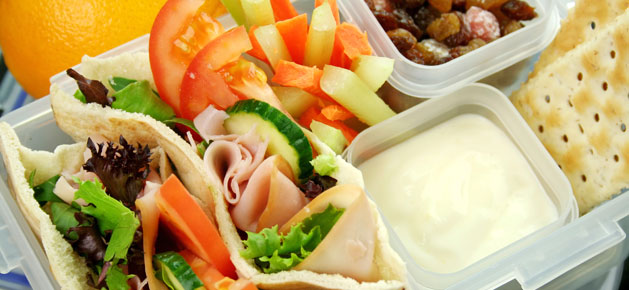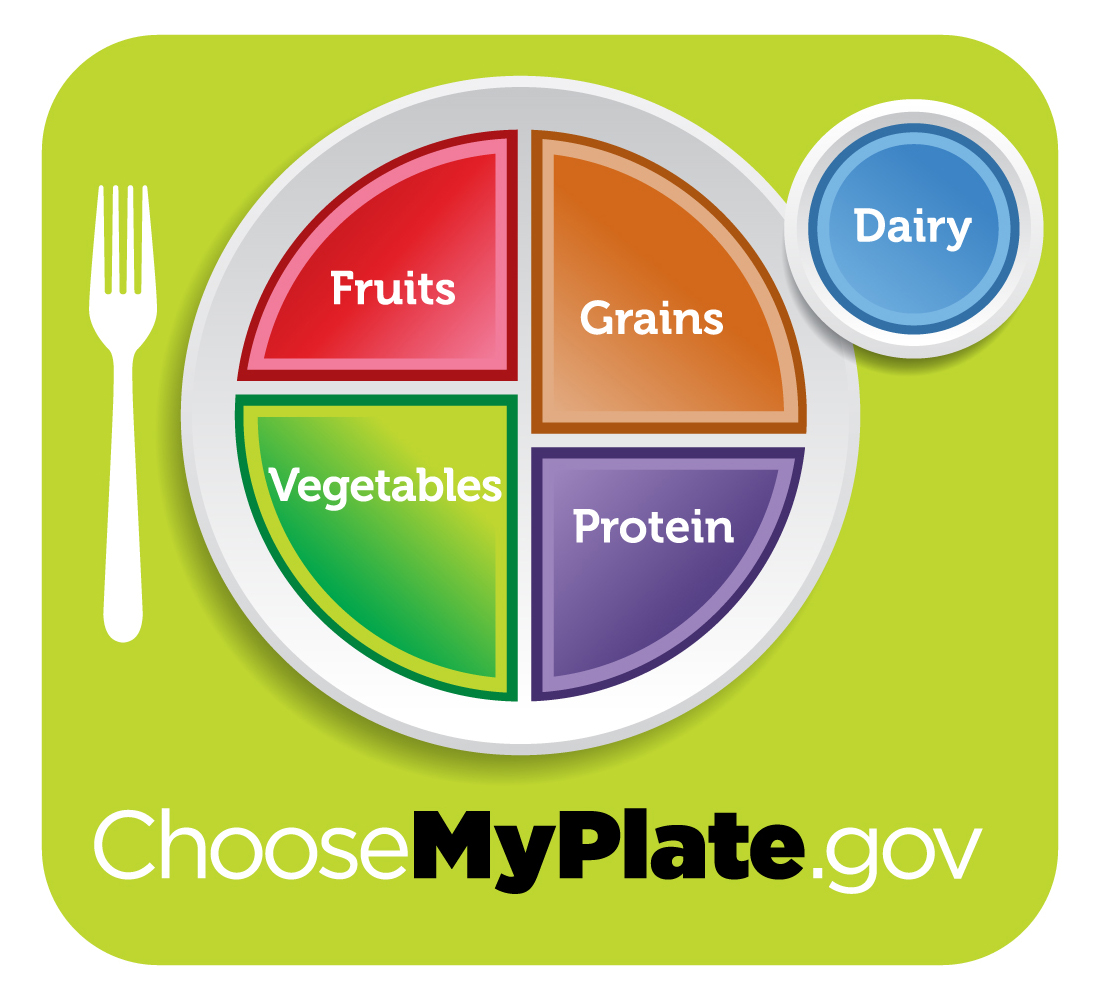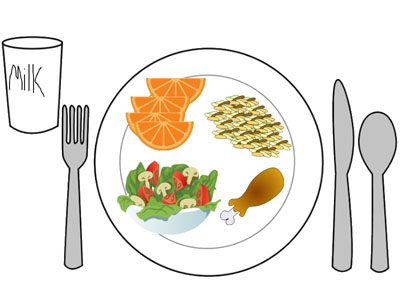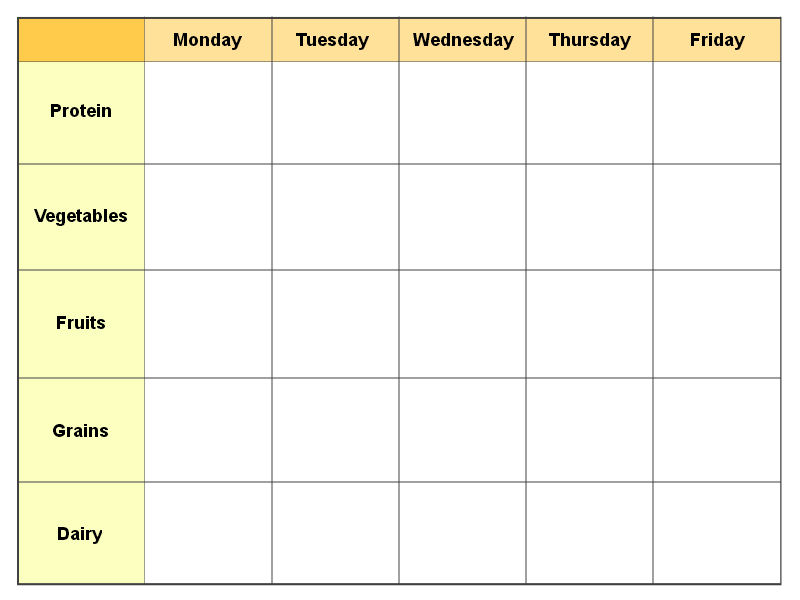

Students often do not like what’s offered for their school lunch, and cafeteria staff hates seeing all of the food that is thrown away. This is your chance to change school lunches!
The food service manager for your school has asked for your class’s help crafting lunches that are both nutritious and delicious! You will learn about food nutrition and create a sample menu for a week of school lunches.
Start by asking your students what it means to be fit or healthy. List their answers on the board or attach them to the wall using sticky notes. Then, ask them to try to group some of their answers together.
You want them to understand that being fit and healthy is a combination of factors, including:
In order to discuss nutritious meals, it’s important to have an understanding of how the body converts food into energy (consuming calories) and expends energy (burning calories).
Ask your students if they think calories are good or bad. Let them debate this for a while so you can see what they know or understand.
Explain that calories are units of heat energy. Our bodies see calories as units of fuel. If 120 calories from broccoli gives your body the same energy as 120 calories from sugary soda or greasy potato chips, does it matter which you eat? Why do we call some calories “empty calories?”
Explain to students that even though solid fats and added sugars increase the number of calories in our food intake, they are referred to as " empty calories" as they do not contribute any nutrients. In addition to energy from calories, our bodies need vitamins, minerals, and even fiber to help keep our digestive systems running properly.
Eating healthy means combining foods with sufficient calories and nutrients (quality calories) to provide our bodies with everything they need to thrive.
Looking back at the three aspects of being healthy listed above:
Spend time reviewing and learning more about the digestive system and how the cells in the body use and store energy.
Explore and discuss healthy eating using the MyPlate image from the USDA. Talk about the different groupings of food and how focusing on portions and food groups can help us eat healthier.

Have students document their food intake for one day. This should include what they ate, how much they ate, and the total calories. If most students eat school lunch, it might be more interesting to have them document what they ate on the weekend.
Depending on your students’ proficiency with and interest in this topic, you may choose to have them categorize their food intake within each of the food groups and list major ingredients and nutrients in each item.
Work as a class to share and categorize students’ favorite foods. Which food group do most choices fall into? Which of their favorite foods are healthy? Evaluate the how each of the food choices meets the USDA recommendations.
Next, brainstorm healthy options for lunch foods as a whole group. Create a list on your white board or develop a Google Document to share with each student.
Ask students to create a visual representation of the lunch they actually ate. Students can use the Balanced Meal activity in Wixie. Once this is complete, ask them to duplicate the page and make adjustments to improve the nutritional value of the meal while still choosing foods they enjoy eating.

Have the students meet in small teams to share and discuss both pages of their projects. Ask students for additional ideas and changes to make their team’s meals more nutritious.
This time is designed to reinforce comprehension of what makes food nutritious, as well as expose students to healthy food choices they were not previously aware of.
As a class, discuss the current school lunch program. How many students use the school lunch program? What do the students think of the food? Do some students bring food from home? Are lunches from home more or less healthy than school lunches?
Most students will not be familiar with the process the cafeteria staff uses to produce the menu, so ask someone from food service to share how they design and deliver the meals. This might even make a great in-house field trip!
A discussion of how the cafeteria works invariably results in some discussion about financial aspects of the food service program. While this is a crucial component of menu planning for food service, consider carefully if you want student work to be constrained by budget. This adds a layer of complexity which can change the focus of their work away from energy transfer and nutrition, and can also increase the time needed to complete the project.
Once students have background knowledge and information about nutritious foods and meals and the menu planning process, let them know that it is their task to provide some healthy suggestions to their school’s food services program. Working in small groups, student teams will design a menu for a week of school lunches that will encourage healthy eating and reduce the amount of food students throw away.

Some groups may want to distribute a survey to another class, or classes, and use the resulting data to help them with their lunch menu design.
Student teams should create a presentation outlining the menu for the entire week, as well as textual and visual information about the items they have chosen to include. If you feel it is necessary to provide structure, you might ask students to create a six-page or six-section presentation that outlines the entire week, a slide for the menu for each day, and a slide that summarizes the research and thinking behind the design.
The final presentation should include both informative and persuasive writing as well as a speaking component. Teams should be prepared to defend why they selected the meals they did and use descriptive and enticing language to persuade the food service program to implement their suggestions.
Have students present their work to members of the school or district food service program and have them evaluate how effective each was in convincing them to implementing change in future menu items. Presentations and proposals should include expository writing and speaking that informs as well as persuasive writing and speaking that seeks to convince others to implement the menu changes.
If school or district personnel can’t attend, invite food service professionals from your community or ask other students in the class to act as experts, relying on the expertise they have gained during the unit.
You could also have students first present to one another and then work together as an entire class to choose the best of the best from each presentation. As a class, students could present their recommendations to the food service program. If your students have enough great ideas, they might even present an entire month’s worth of meal ideas.
Even if you aren’t able to share student work with an authentic audience, be sure to use the opportunity to start more class discussion about healthy eating and brainstorm other non-food-service ideas for getting students to eat healthy foods.
As you activate prior knowledge about calories and health at the start of the lesson, assess how much students already know about nutrition. Use their documentation of daily food intake as an opportunity for individual discussions that will help you identify misconceptions.
The changes students make to their meal choices in the Balanced Meal activity and the follow-up small group discussions provide opportunities to solidify knowledge about nutrition, as well as prompt thinking about how information can impact our motivation to take action and change behavior.
The proposal project file should include examples of both informative and persuasive writing. You can also evaluate students’ writing for their ability to develop and communicate with images and diagrams.
The presentation provides an opportunity to assess speaking and oral presentation skills. You may also want to consider evaluating the project management, teamwork, planning, and organization that occurred during the process.
Connie Liakos Evers. How to Teach Nutrition to Kids ISBN: 0964797003
Janice VanCleave. Food and Nutrition for Every Kid: Easy Activities That Make Learning Science Fun ASIN: B0024NK5PG (Kindle)
My Plate – US Department of Agriculture
My Plate Resource Guide - KaTom
School Gardens and Salad Bars – Whole Kids Foundation (Whole Foods)
REGIS: A Nurse's Guide to the Food Pyramid
Organization for Matter and Energy Flow in Organisms
MS-LS1-7. Develop a model to describe how food is rearranged through chemical reactions forming new molecules that support growth and/or release energy as this matter moves through an organism.
Ecosystems: Interactions, Energy, and Dynamics
MS-LS2-4. Construct an argument supported by empirical evidence that changes to physical or biological components of an ecosystem affect populations.
Writing
Text Types and Purpose
2. Write informative/explanatory texts to examine a topic and convey ideas, concepts, and information through the selection, organization, and analysis of relevant content.
2a. Introduce a topic; organize ideas, concepts, and information, using strategies such as definition, classification, comparison/contrast, and cause/effect; include formatting (e.g., headings), graphics (e.g., charts, tables), and multimedia when useful to aiding comprehension.
Production and Distribution of Writing:
4. Produce clear and coherent writing in which the development, organization, and style are appropriate to task, purpose, and audience. (Grade-specific expectations for writing types are defined in standards 1-3 above.)
6. Use technology, including the Internet, to produce and publish writing as well as to interact and collaborate with others; demonstrate sufficient command of keyboarding skills to type a minimum of three pages in a single sitting.
3. Knowledge Constructor
Students critically curate a variety of resources using digital tools to construct knowledge, produce creative artifacts and make meaningful learning experiences for themselves and others. Students:
a. plan and employ effective research strategies to locate information and other resources for their intellectual or creative pursuits.
b. evaluate the accuracy, perspective, credibility and relevance of information, media, data or other resources.
c. curate information from digital resources using a variety of tools and methods to create collections of artifacts that demonstrate meaningful connections or conclusions.
d. build knowledge by actively exploring real-world issues and problems, developing ideas and theories and pursuing answers and solutions.
6. Creative Communicator
Students communicate clearly and express themselves creatively for a variety of purposes using the platforms, tools, styles, formats and digital media appropriate to their goals. Students:
a. choose the appropriate platforms and tools for meeting the desired objectives of their creation or communication.
b. create original works or responsibly repurpose or remix digital resources into new creations.
c. communicate complex ideas clearly and effectively by creating or using a variety of digital objects such as visualizations, models or simulations.
d. publish or present content that customizes the message and medium for their intended audiences.

Follow us on Instagram for daily inspiration

Create a thought web, cluster, flowchart, or other graphic organizer for a lesson
8 first projects to get students using technology
Creative, digital book reviews
Fun and powerful ideas with animated characters

Wixie
Share your ideas, imagination, and understanding through writing, art, voice, and video.

Rubric Maker
Create custom rubrics for your classroom.

Pics4Learning
A curated, copyright-friendly image library that is safe and free for education.

Wriddle
Write, record, and illustrate a sentence.

Get creative classroom ideas delivered straight to your inbox once a month.
Topics